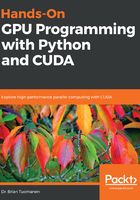
Ensuring that we have the right hardware
For this book, we recommend that you have the following hardware as a minimum:
- 64-bit Intel/AMD-based PC
- 4 gigabytes (GB) of RAM
- NVIDIA GeForce GTX 1050 GPU (or higher)
This configuration will ensure that you can comfortably learn GPU programming, run all of the examples in this book, and also run some of the other newer and interesting GPU-based software, such as Google's TensorFlow (a machine learning framework) or the Vulkan SDK (a cutting-edge graphics API).
As stated, we will be assuming that you are using either the Windows 10 or Ubuntu LTS (long-term support) release.
Ubuntu LTS, is by and large, the most mainstream version of Linux, which ensures maximum compatibility with new software and toolkits. Keep in mind there are many variations of Linux that are based on Ubuntu, such as Linux Mint or Xubuntu, and these generally work equally well. (I have personally found that Linux Mint works fairly well out of the box for GPU-equipped laptops.)
We should note that we are assuming that you have at least an entry-level GTX 1050 (Pascal) GPU, or the equivalent in any newer architecture. Note that many of the examples in this book will most likely work on most older GPUs, but they have only been tested on a GTX 1050 (under Windows 10) and GTX 1070 (under Linux) by the author. While the examples haven't been tested on older GPUs, a 2014-era entry level Maxwell architecture GPU, such as a GTX 750, should also be sufficient for the purposes of this text.